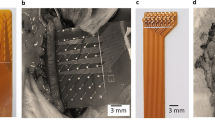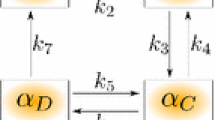Abstract
The generally accepted mechanism for global uterine coordination is propagation of electrical activity. Mechanotransduction mechanisms were briefly considered as a secondary mechanism 40 years ago, but scant data have appeared. Here, we provide evidence that tissue strips are capable of functionally interacting solely by mechanical mechanisms. We mechanically linked, in series, 2 rat myometrial strips of similar size. Strips were placed in separate baths to ensure they were electrically and chemically isolated. A force transducer was used to measure force production. We precisely determined when each tissue contracted by simultaneously measuring each strip’s electrical activity using contact electrodes. We observed both in-phase and out-of-phase contraction patterns from the tissues. To determine whether modulation of the electrical properties of the tissue is involved in the mechanotransduction mechanism, we briefly stretched single tissue strips during alternate contractions. This technique provided a control contraction for each test contraction. The duration of the contraction that was stretched measured longer than the control in 33 of 35 pairs (P =.0001, Wilcoxon signed-rank test for paired data). Interestingly, briefly slackening the tissue also prolonged the force-producing phase of that contraction (39 of 42 pairs; P =.0006). Because our data show that mechanotransduction mechanisms coordinate tissue-level contractions, we speculate that mechanotransduction mechanisms may contribute to organ-level coordination of contractions.
Similar content being viewed by others
References
Csapo AI. The effects of ovariectomy and stretch on the regulatory profile and activity of the uterus. Prostaglandins. 1977;13(5):965–973.
Csapo AI, Takeda H. Effect of progesterone on the electric activity and intrauterine pressure of pregnant and parturient rabbits. Am J Obstet Gynecol. 1965;91:221–231.
Csapo A. The diagnostic significance of the intrauterine pressure. II. Clinical considerations and trials. Obstet Gynecol Surv. 1970;25(6):515–543.
Csapo A. The diagnostic significance of the intrauterine pressure. I. Obstet Gynecol Surv. 1970;25(5):403–435.
Takeda H. Generation and propagation of uterine activity in situ. Fertil Steril. 1965;16:113–119.
Sigger JN, Harding R, Jenkin G. Relationship between electrical activity of the uterus and surgically isolated myometrium in the pregnant and nonpregnant ewe. J Reprod Fertil. 1984;70(1):103–114.
Miller SM, Garfield RE, Daniel EE. Improved propagation in myometrium associated with gap junctions during parturition. Am J Physiol. 1989;256(1 pt 1):C130–C141.
Young RC, Bemis A. Calcium-activated chloride currents prolongs the duration of contractions in pregnant rat myometrial tissue. Reprod Sci. 2009;16(8):734–739.
Young RC, Zhang P. Tissue-level bioelectrical signals as the trigger for uterine contractions in human pregnancy. J Soc Gynecol Investig. 2004;11(7):478–482.
Kawarabayashi T, Kishikawa T, Sugimori H. Characteristics of action potentials and contractions evoked by electrical-field stimulation of pregnant human myometrium. Gynecol Obstet Investig. 1988;25(2):73–79.
Wikland M, Lindblom B. Relationship between electrical and mechanical activity of the isolated term-pregnant human myometrium. Eur J Obstet Gynecol Reprod Biol. 1985;20(6):337–346.
Chen CJ, Chiang ST. Activities of uterine muscles from rats in late pregnancy. Proc Natl Sci Counc Repub China B. 1989;13(1):42–46.
Osol G, Brekke JF, McElroy-Yaggy K, Gokina NI. Myogenic tone, reactivity, and forced dilatation: a three-phase model of in vitro arterial myogenic behavior. Am J Physiol. 2002;283(6):H2260–H2267.
Veerareddy S, Cooke CL, Baker PN, Davidge ST. Vascular adaptations to pregnancy in mice: effects on myogenic tone. Am J Physiol. 2002;283(6):H2226–H2233.
Hurd WW, Gibbs SG, Ventolini G, Horowitz GM, Guy SR. Shortening increases spontaneous contractility in myometrium from pregnant women at term. Am J Obstet Gynecol. 2005;192(4):1295–1301; discussion 1301–1293.
Hurd WW, Gibbs SG, Rudinsky KA. Differential regulation of myometrial prostaglandin production by changes in length. Am J Obstet Gynecol. 2008;198(2):225 e1–225 e4.
Hauth JC, Hankins GD, Gilstrap LC 3rd, Strickland DM, Vance P. Uterine contraction pressures with oxytocin induction/augmentation. Obstet Gynecol. 1986;68(3):305–309.
Basford JR. The Law of Laplace and its relevance to contemporary medicine and rehabilitation. Arch Phys Med Rehabil. 2002;83(8):1165–1170.
Author information
Authors and Affiliations
Corresponding author
Rights and permissions
About this article
Cite this article
Young, R.C., Goloman, G. Mechanotransduction in Rat Myometrium: Coordination of Contractions of Electrically and Chemically Isolated Tissues. Reprod. Sci. 18, 64–69 (2011). https://doi.org/10.1177/1933719110379637
Published:
Issue Date:
DOI: https://doi.org/10.1177/1933719110379637




